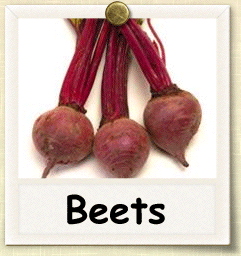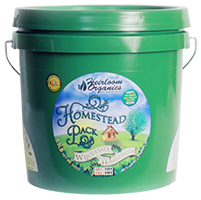|
Home > Guides > Vegetables > Beet |
|
How to Grow Beets | Guide to Growing Beets |
|
|
|
|
| |
 |
|
Overview |
|
|
|
|
|
| |
|
| |
Easy-to-grow beets do double-duty in the kitchen, producing tasty roots for baking, boiling or sautéing and fresh greens to boil or steam. Plant them early for top quality and best flavor. (Fluctuating weather can reduce quality and create white zone rings in the roots.) Some varieties have red stems and venation in the leaves, making them a natural for edible landscaping. |
|
| |
|
|
| |
Growing Guide
GROWING NOTES
Prefers well-drained sandy loam to silt loam soil, high in organic matter, with pH between 6.5 and 7 and free of large stones. Good soil structure is important because growth is improved by good soil aeration. Beets grow poorly in acid soil. They tolerate low fertility but require consistent moisture. Do not plant in soils with pH less than 6.0.
Beets use boron inefficiently. Boron is less available in soils with high pH and high organic matter. Corky black areas in the roots indicate boron deficiency.
Biennial grown as an annual.
Some varieties have red stems and leaf venation.
MAINTAINING
Plant in early spring, as soon as you can work the soil, ¾ inch deep and 1 inch apart in rows 12 to 18 inches apart. For continuous harvest, make successive plantings every three weeks until midsummer. For winter storage, sow crop about 10 weeks before heavy freeze.
The wrinkled “seedball” usually contains two to four viable seeds, making it necessary to thin to 3- to 4-inch spacings if you plan to harvest young, small or cylindrical-shaped roots, or 6-inch spacings for larger roots for winter storage.
Begin thinning when seedlings are about 4 to 5 inches tall, and eat the thinnings. Cut rather than pull plants when thinning to avoid disturbing roots of other plants.
Some "monogerm" varieties have only one seed per fruit. Some seed companies remove seeds from the seedball.
Unlike most root crops, beets can be started inside or in cold frames and transplanted into the garden.
Use floating row covers to discourage insects early in the season.
Keep well-weeded. Competition and uneven watering can make beets stringy and tough.
Beets are closely related to Swiss chard and spinach. Avoid following these crops in rotation.
Beets tolerate average to low fertility. Too much nitrogen will encourage top growth at the expense of root development.
Best color and flavor develop under cool conditions and bright sun. When beets mature in warm weather, they are lighter colored, have less sugar and have more pronounced color zoning in the roots. Fluctuating weather conditions produce white zone rings in roots.
Beets are biennials. Normally, they produce an enlarged root during their first season. Then after overwintering they produce a flower stalk. If they experience two to three weeks of temperatures below 45 F after they have formed several true leaves during their first season, a flower stalk may grow prematurely. Many newer varieties are less sensitive to this problem.
|
|
| |
|
| |
Heirloom seeds are the gardeners choice for seed-saving from year-to-year. Learning to save seeds is easy and fun with these books. Before you harvest, consider which varieties you might want to save seeds from so that your harvesting practice includes plants chosen for seed saving. Be sure to check out our newest seed packs, available now from Heirloom Organics. The Super Food Garden is the most nutrient dense garden you can build and everything you need is right here in one pack. The Genesis Garden s a very popular Bible Garden collection. The Three Sisters Garden was the first example of companion planting in Native American culture. See all of our brand-new seed pack offerings in our store.
|
|
| |
|
|
| |
Harvesting Guide
HARVESTING
Beets can be harvested whenever they grow to the desired size. About 60 days are required for beets to reach 1 1/2 inches in diameter, the size often used for cooking, pickling or canning as whole beets. Beets enlarge rapidly to 3 inches with adequate moisture and space. With most varieties, beets larger than 3 inches may become tough and fibrous. Beets may be stored in a polyethylene bag in a refrigerator for several weeks. Beets also may be stored in outdoor pits if the beets are dug before the ground freezes in the fall. Cut off the tops of the beets one inch above the roots. Beets store best at 32°F and 95 percent humidity. Do not allow them to freeze.
When harvesting beets, separate the green tops from the roots leaving an inch of stem on the beet. Beets larger than 3 inches in diameter are often fibrous and woody. Beet greens are packed with nutritional value but must be prepared separately. Upon storage the greens will quickly draw the moisture from the root greatly reducing flavor and the beets will become shriveled. Leave one inch stem and the taproot intact to retain moisture and nutrients. After separating, beets store well for about a week in perforated plastic bags in the refrigerator. Use beets while they are still firm and fresh.
SAVING SEEDS
Saving beet seeds is a two-year project because this biennial doesn't flower and produce its seed clusters until the next growing season. Tie up the stalks to stakes when they become floppy, look for bloosoms in June and July, and harvest the seeds in August. Cut off the tops and allow them to dry under cover, then strip off the seeds. Restrict yourself to a single variety each year if you will be saving seeds, beet seeds have a talent for cross-pollinatin over distances of a mile or more.
|
|
| |
|
|
|
| |
|
|
|
|
|
| You can find this variety in the following Seed Packs: |
|
  
  |
|
| Click the packs below to see some of our other wonderful products |
|
|
|
|
|
|
|